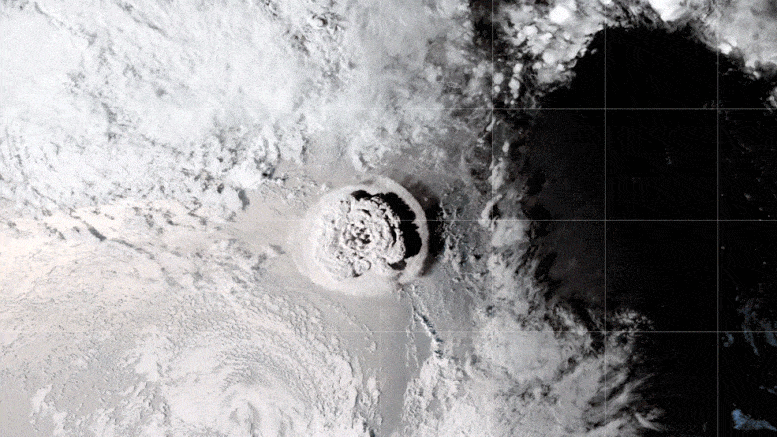
التقط القمر الصناعي GOES-17 صورًا لسحابة مظلة ناتجة عن ثوران بركان هونغ تونغا – هونغ هاباي تحت الماء في 15 يناير 2022. كما يمكن رؤية موجات صدمية على شكل هلال والعديد من ضربات الإضاءة. الائتمان: صورة مرصد الأرض التابع لناسا بواسطة جوشوا ستيفنز باستخدام صور GOES بإذن من NOAA و NESDIS
عندما اندلع بركان هونغ تونغا – هونغ هاباي في 15 كانون الثاني (يناير) 2022 ، أرسل موجات الصدمة الجوية ، والطفرات الصوتية ، وموجات تسونامي في جميع أنحاء العالم. الآن ، وجد العلماء أن تأثيرات البركان وصلت أيضًا إلى الفضاء.
عند تحليل البيانات من مستكشف الاتصال الأيوني التابع لناسا ، أو ICON ، والمهمة والأقمار الصناعية Swarm التابعة لوكالة الفضاء الأوروبية (وكالة الفضاء الأوروبية) ، وجد العلماء أنه في الساعات التي أعقبت الانفجار ، تشكلت رياح بسرعة الإعصار وتيارات كهربائية غير عادية في طبقة الأيونوسفير – الغلاف الجوي العلوي المكهرب للأرض طبقة على حافة الفضاء.
قال برايان هاردينغ ، عالم الفيزياء في[{” attribute=””>University of California, Berkeley, and lead author on a new paper discussing the findings. “It is allowing us to test the poorly understood connection between the lower atmosphere and space.”

The Hunga Tonga-Hunga Ha’apai eruption on January 15, 2022, caused many effects, some illustrated here, that were felt around the world and even into space. Some of those effects, like extreme winds and unusual electric currents were picked up by NASA’s ICON mission and ESA’s (the European Space Agency) Swarm. Image not to scale. Credit: NASA’s Goddard Space Flight Center/Mary Pat Hrybyk-Keith
ICON launched in 2019 to identify how Earth’s weather interacts with weather from space – a relatively new idea supplanting previous assumptions that only forces from the Sun and space could create weather at the edge of the ionosphere. In January 2022, as the spacecraft passed over South America, it observed one such earthly disturbance in the ionosphere triggered by the South Pacific volcano.
“These results are an exciting look at how events on Earth can affect weather in space, in addition to space weather affecting Earth,” said Jim Spann, space weather lead for NASA’s Heliophysics Division at NASA Headquarters in Washington, D.C. “Understanding space weather holistically will ultimately help us mitigate its effects on society.”
When the volcano erupted, it pushed a giant plume of gases, water vapor, and dust into the sky. The explosion also created large pressure disturbances in the atmosphere, leading to strong winds. As the winds expanded upwards into thinner atmospheric layers, they began moving faster. Upon reaching the ionosphere and the edge of space, ICON clocked the windspeeds at up to 450 mph – making them the strongest winds below 120 miles altitude measured by the mission since its launch.
In the ionosphere, the extreme winds also affected electric currents. Particles in the ionosphere regularly form an east-flowing electric current – called the equatorial electrojet – powered by winds in the lower atmosphere. After the eruption, the equatorial electrojet surged to five times its normal peak power and dramatically flipped direction, flowing westward for a short period.
“It’s very surprising to see the electrojet be greatly reversed by something that happened on Earth’s surface,” said Joanne Wu, a physicist at University of California, Berkeley, and co-author on the new study. “This is something we’ve only previously seen with strong geomagnetic storms, which are a form of weather in space caused by particles and radiation from the Sun.”

ESA’s constellation of three Swarm satellites is designed to identify and measure precisely different magnetic signals. This will lead to new insight into many natural processes, from those occurring deep inside the planet, to weather in space caused by solar activity. Credit: ESA/ATG Medialab
The new research, published today (May 10, 2022) in the journal Geophysical Research Letters, is adding to scientists’ understanding of how the ionosphere is affected by events on the ground as well as from space. A strong equatorial electrojet is associated with redistribution of material in the ionosphere, which can disrupt GPS and radio signals that are transmitted through the region.
Understanding how this complex area of our atmosphere reacts in the face of strong forces from below and above is a key part of NASA research. NASA’s upcoming Geospace Dynamics Constellation, or GDC, mission will use a fleet of small satellites, much like weather sensors on the ground, to track the electrical currents and atmospheric winds coursing through the area. By better understanding what affects electrical currents in the ionosphere, scientists can be more prepared to predict severe problems caused by such disturbances.
Reference: “Impacts of the January 2022 Tonga Volcanic Eruption on the Ionospheric Dynamo: ICON-MIGHTI and Swarm Observations of Extreme Neutral Winds and Currents” by Brian J. Harding, Yen-Jung Joanne Wu, Patrick Alken, Yosuke Yamazaki, Colin C. Triplett, Thomas J. Immel, L. Claire Gasque, Stephen B. Mende and Chao Xiong, 10 May 2022, Geophysical Research Letters.
DOI: 10.1029/2022GL098577

“مدمن ثقافة البوب. عشاق التلفزيون. نينجا الكحول. إجمالي مهووس البيرة. خبير تويتر محترف.”


:max_bytes(150000):strip_icc():focal(749x0:751x2)/Shohei-Ohtani-dog-first-pitch-tout-1-082924jpg-953710b5907e41dfa6827ec1c99cf28b.jpg)
/cdn.vox-cdn.com/uploads/chorus_asset/file/25594197/Genki_TurboCharger_Hero.jpg)


More Stories
المفتش العام لوكالة ناسا يصدر تقريرا قاسيا بشأن تأخير مشروع إطلاق المركبة الفضائية SLS
كيف أصبحت الثقوب السوداء بهذا الحجم والسرعة؟ الإجابة تكمن في الظلام
طالبة من جامعة نورث كارولينا ستصبح أصغر امرأة تعبر حدود الفضاء على متن بلو أوريجين